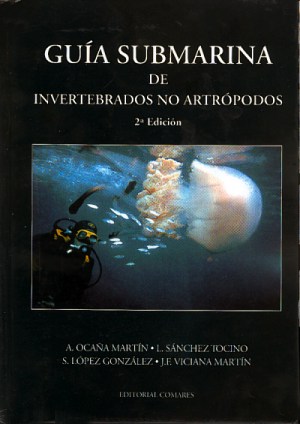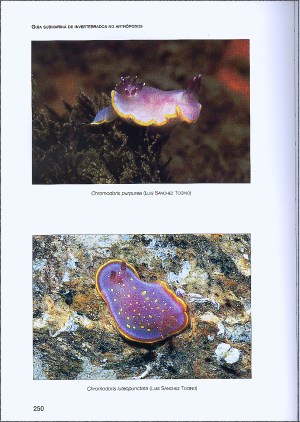

Guía Submarina de Invertebrados No Artrópodos. 2nd Ed.
A. Ocaña Martin, L. Sanchez Tocino, S. Lopez Gonzalez & J.E. Viciana Martin.
2000
Publisher: Editorial Comares. Granada. http://www.comares.com
Language: Spanish
ISBN 84-8444-121-0
471 pages [Opisthobranchs pp 203 - 280]
Price: 6000 ptas. - 36.06 Euros
This book is, as far, the best marine invertebrates (non arthropods) guide published in Spain. However, the book does not mention any Pseudocoelomate groups, probably because these animals are not easy to find and collect for non experts. For this reason, the present book is useful for divers and students, and also for researchers and non experts interested in specificgroups. The section on the opisthobranch molluscs is well documented and updated. Thus, recently described or rarely recorded species are included in this guide (for example, Tambja marbellensis, Trapania hispalensis, Chromodoris luteopunctata, Hypselodoris malacitana, Geitodoris portmanni, Jorunna onubensis, Polycera aurantiomarginata, Piseinotecus gabinieri). Of over 500 color illustrations in the book, 106 are of Opisthobranchs.
To date, most divers, students and university teaching/researchers from southern Spain did not have enough good local or regional identification guides for most of the common marine invertebrates, and had to use some Eastern Mediterranean or northeastern European guides, despite the southern Iberian Peninsula coasts probably having the highest degree of marine biodiversity in Europe. The present book is the 2nd edition of the first of a series of guides that the authors expect to publish. This edition corrected errors of printing in the first and includes additional information and species.
The treatment of each phyla in the book includes a general introduction and the most important anatomical and biological characteristics of the phyla, as well as those of the higher taxonomical categories of each phyla (Class, Order, Family). Then, all the known species found in the Granada littoral (Southern Spain) of the different phyla are described externally and some details of their biology are supplied. Moreover, description and figures of internal structures are given in some phyla (spicules/sponges and anthozoans; internal skeleton/some colonial anthozoans; oscicles/holothurioideans). Photographs of all described species are included. A glossary of the specialized used terms, withy numerous schematic draws, are available at the end of the book.
However, one of the main problem of this book is for those non Spanish readers, since the book is written exclusively in Spanish and not even has short description of the species in English. This is because the main target of this book are local/regional collectors, divers, photographers or students.
Various Spanish experts acted as advisors in several higher taxa: i.e. Drs. J.L. Carballo and M. J. Uriz (Sponges), Dr. P.J. López González (Anthozoans), Drs. P. García-Corrales and M.D. Medel Soteras (Hydrozoans), Dr. J. M. Gili (Scyphozoans and Ctenophores), Dr. N. Anadón (Nemerteans), Dr. J.I. Saiz-Salinas (Sipunculids), Dr. G. San Martín (Polychaetes), Dr. J. Templado (“Prosobranchs”), Dr. F.J. García (Opisthobranchs), Dr. C. Salas (Bivalves), Dr. J.M. Viéitez (Phoronids), etc. This makes the book particulalrly valuable, although in some groups the most recent classifications (i.e. gastropods) are not followed. The book has certainly made the identification of the common species of invertebrates from the subject geographical area much easier.
Finally, even if the length of the Granada littoral is only about 50 Kms, this book will be very useful along all the southern Iberian Peninsula coast and, even, along the rest of the Spanish Mediterranean coasts.
Juan Lucas Cervera
Cervera, J.L., 2001 (June 21) Guía Submarina de Invertebrados No Artrópodos. 2nd Ed.. A. Ocaña Martin, L. Sanchez Tocino, S. Lopez Gonzalez & J.E. Viciana Martin.. [In] Sea Slug Forum. Australian Museum, Sydney. Available from http://www.seaslugforum.net/factsheet/brocana1
